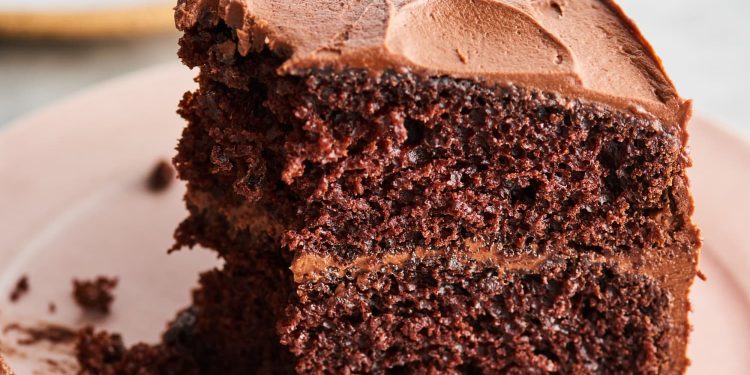We independently select these products—if you buy from one of our links, we may earn a commission.
Because my mom is a huge fan of chocolate cake, it was the first cake (and maybe even the first dessert) I taught myself to bake when I was a kid. And Mom’s right: There’s nothing quite like a humble slice of chocolate cake enveloped in a rich, chocolaty icing. Through years of baking — after those simple, single-layer cakes evolved into triple-layer cakes and the recipes and designs got a little more adventurous — I’ve dialed in my chocolate cake recipe. Here are my tips for creating a moist, tender, flavorful, Mom-approved chocolate cake.
How to Make the Best Chocolate Cake
1. Use quality chocolate and cocoa powder.
Chocolate cake is all about the chocolate, so make sure you’re baking with a brand of chocolate you love — the tastier the chocolate that goes into the cake, the better the cake will be. I think Ghirardelli’s dark chocolate bars and their unsweetened and Dutch processed cocoa powders are delicious and also affordable. But I’ve had success with lots of generic store brands too, so try a few options to see what brands are your favorites.
2. Don’t skip sifting the dry ingredients.
For a chocolate cake, it’s very important to sift all of your dry ingredients together. Start by whisking all of the dry ingredients together in a bowl and then dust them through a sieve. This evenly distributes the leavening agent(s), and breaks up any large clumps of cocoa powder, making sure the acids and bases and the wet and dry ingredients are all mingling together within the batter, which produces a lighter, fluffier cake. (More on acids and bases below.)
3. Use oil instead of butter in your batter.
Generally speaking, oils, like canola oil or vegetable oil, which are 100 percent fat, will make a better chocolate cake than butter, which is roughly 80 percent fat and 20 percent water. When a butter-based cake bakes, the water in the butter evaporates, often leaving you with a slightly dry cake. If you use oil, the additional fat will add more moisture to the cake. Also, because unsaturated fats like oil stay in liquid form at room temperature, the cake will also stay moist once it’s completely cooled.
4. Have your acids and bases sorted out.
To make a chocolate cake with the proper texture, you need a delicate balance of acids and bases. Once they activate each other, they’ll produce little pockets of air in the batter, causing the cake to rise taller in the oven and have a lovely, fluffy crumb. Natural cocoa is an acid that needs baking soda (a base) to neutralize it. Failing to strike the perfect balance between the two could give your cake a bitter or soapy flavor or cause it to collapse. Whenever I want to make it easy on myself, I pair buttermilk (an acid) with baking soda, and use Dutch process cocoa, which has already been neutralized and won’t be reactive. (Learn more about the differences between natural cocoa powder and Dutch process cocoa powder.)
And a side note: Be sure to check the expiration date on your baking soda and baking powder, especially if they’ve been sitting in the cabinet for a bit, because nothing is worse than wasting a bunch of great ingredients on a cake that will never rise. A quick way to test them is by adding a pinch to a small bowl with some vinegar or lemon juice. If it bubbles, it’s still active.
5. Add some of your favorite coffee to the mix.
Many chocolate cake recipes call for adding boiling water to the batter right before the cake goes into the oven. This thins the batter so the cake won’t be so dense, activates the chemical leaveners to give the cake a pre-bake lift, and it also blooms the cocoa powder to help release all of its yummy flavors. But water is also bland, so I prefer to use something with a lot more flavor, like a cup of delicious dark-roast coffee. You want to use something that’s robust and rounded (don’t use instant coffee) and make sure it’s boiling hot. Bonus: Coffee will enhance the flavor of chocolate without making your cake taste strongly of coffee. (Try this Southern-style chocolate cake with ganache frosting recipe or Ina Garten’s chocolate cake for two delicious examples of why you should add coffee to your chocolate cake.)
The icing is half of the chocolate cake battle, and a bad one has the potential to ruin the entire experience. Choose an icing recipe you wouldn’t mind eating on its own, and make sure your cake has cooled completely — maybe even chill it in the fridge — before you ice it, especially if you’re icing it with a buttercream frosting. For even more flavor in your frosting, you can add extras like malted milk powder, buttermilk powder, espresso powder, or chocolate liquor. My favorite way to finish a chocolate cake is with a silky chocolate ganache that’s roughly one part melted chocolate and one part heavy cream, because that’s how Mom always liked it. And you know what? She’s right.

